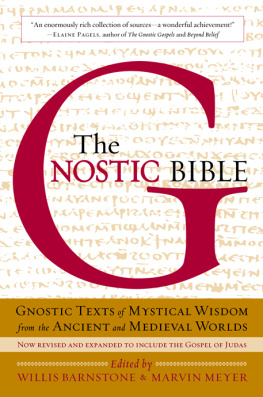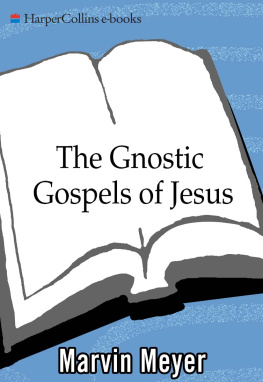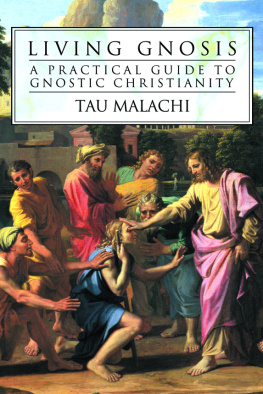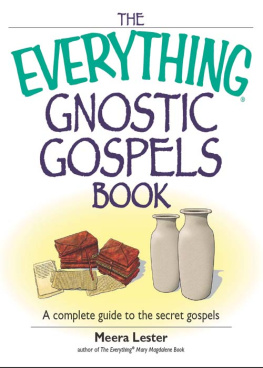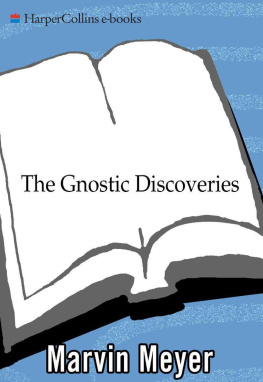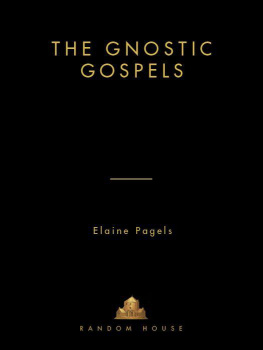Clear and luminous translations that capture the essence and poetic beauty of these iridescent texts. Essential Gnostic Scriptures provides further stepping-stones for seekers of wisdom and knowledge beyond the canonical testaments, or for those who are simply moved by great sacred poetry.
Jeffrey Henderson, Editor, Loeb Classical Library
Fresh and remarkable readable translations of some of the most important gnostic books discovered in modern times, including the newly released Gospel of Judas. With its clear and up-to-date introduction to gnostics and their religion, Essential Gnostic Scriptures will be an invaluable resource for anyone interested in one of the most important religious movements of the ancient world.
Bart D. Ehrman, author of Jesus, Interrupted and Lost Christianities
ABOUT THE BOOK
The people weve come to call gnostics were passionate advocates of the view that salvation comes through knowledge and personal experience, and their passion shines through in the remarkable body of writings they produced over a period of more than a millennium and a half. Willis Barnstone and Marvin Meyer have created a translation that brings the gnostic voices to us from across the centuries with remarkable power and beautybeginning with texts from the earliest years of Christianityincluding material from the Nag Hammadi libraryand continuing all the way up to expressions of gnostic wisdom found within Islam and in the Cathar movement of the Middle Ages. The twenty-one texts included here serve as a compact introduction to Gnosticism and its principal ideasand they also provide an entre to the pleasures of gnostic literature in general, representing, as they do, the greatest masterpieces of that tradition.
WILLIS BARNSTONE, PhD, is Distinguished Professor of Comparative Literature at Indiana University. His many books include The Poetics of Translation, The Other Bible, The New Covenant, The Complete Poems of Sappho, and The Restored New Testament.
MARVIN MEYER, PhD, (19482012) was Griset Professor of Bible and Christian Studies in the Department of Religious Studies at Chapman University in Orange, California. His books include The Gospel of Thomas and The Ancient Mysteries.
Sign up to learn more about our books and receive special offers from Shambhala Publications.

Or visit us online to sign up at shambhala.com/eshambhala.
ESSENTIAL
GNOSTIC
SCRIPTURES
Willis Barnstone
and Marvin Meyer

SHAMBHALA
Boston & London
2010
SHAMBHALA PUBLICATIONS, INC.
Horticultural Hall
300 Massachusetts Avenue
Boston, Massachusetts 02115
www.shambhala.com
2010 by Willis Barnstone and Marvin Meyer
All rights reserved. No part of this book may be reproduced in any form or by any means, electronic or mechanical, including photocopying, recording, or by any information storage and retrieval system, without permission in writing from the publisher.
LIBRARY OF CONGRESS CATALOGING-IN-PUBLICATION DATA
Essential gnostic scriptures/[compiled by] Willis Barnstone and Marvin Meyer.1st ed.
p. cm.
Includes bibliographical references.
eISBN 978-0-8348-2215-3
ISBN 978-1-59030-549-2 1.Gnosticism.
I. Barnstone, Willis, 1927 II. Meyer, Marvin.
BT1390.E86 2010
299.932dc22
2010023009
MARVIN MEYER
Gnosis and Gnostics
The religious mystics designated as gnostics were spiritual people who announced a way of salvation through gnosis, or knowledge. They proclaimed that a person should know oneself, should know the inner person, and thereby gnostic men and women may come to a direct knowledge of god. With such gnosis, people could experience freedom and independence from the mediation of rabbis, priests, bishops, imams, or other authorities. Religious authorities were not pleased, and they condemned the gnostics as heretics, threats to the well-being of organized religion. In particular, heresiologistsheresy hunters who attempted to expose people considered dangerous to the Christian massesfulminated against what they maintained was the falsehood of the gnostics. Still, from the challenge of this perceived threat came a great deal of the theological reflection that has characterized the intellectual history of the Christian church.
The historical roots of the gnostics reach back into the time of the Greeks, Romans, and Second Temple Jews. Some gnostics were Jewish, others Greco-Roman, and many were Christian. There were Mandaean gnostics from Iraq and Iran; Manichaeans from Europe, the Middle East, North Africa, and all the way to China; Islamic gnostics in the Muslim world; and Cathars in western Europe. The heyday of their influence extends from the second century C.E. through the next several centuries. Their influence and their presence, some say, continue to the present day.
Gnostics sought knowledge and wisdom from many different sources, and they accepted insight wherever it could be found. Like those who came before them, they embraced wisdom, Sophia, understood variously and often taken as the personified manifestation of divine insight. To gain knowledge of the deep things of god, gnostics read and studied diverse religious and philosophical texts. In addition to Jewish sacred literature, Christian documents, and Greco-Roman religious and philosophical texts, gnostics studied religious works from the Egyptians, Mesopotamians, Zoroastrians, Muslims, and Buddhists. All such sacred texts disclosed truths, and all were to be celebrated for their wisdom.
Gnostics loved to explore who they were and where they had come from, and hence they read creation stories such as the opening chapters of Genesis with vigor and enthusiasm. Like other interpreters, they recognized that creation stories not only claim to describe what was once upon a time, but also suggest what is now, in our own world. The gnostics carried to their reading a conviction that the story of creation was not a happy one. There is, they reasoned, something fundamentally wrong with the world, there is too much evil and pain and death in the world, and so there must have been something wrong with creation.
Consequently, gnostics provided innovative and oftentimes disturbing interpretations of the creation stories they read. They concluded that a distinction, often a dualistic distinction, must be made between the transcendent, spiritual deity, who is surrounded by heavenly entities known as aeons and who is all wisdom and light, and the creator of the world, who is at best incompetent and at worst malevolent. Yet through everything, they maintained, a spark of transcendent knowledge, wisdom, and light persists within people who are in the know. The transcendent deity is the source of that enlightened life and light. The meaning of the creation drama, when properly understood, is that human beingsgnostics in particularderive their knowledge and light from the transcendent god, but through the mean-spirited actions of the demiurge, the creator of the world, they have been confined within this world. (The Platonic aspects of this imagery are apparent.) Humans in this world are imprisoned, asleep, drunken, fallen, ignorant. They need to find themselvesto be freed, awakened, made sober, raised, and enlightened. In other words, they need to return to gnosis.
This distinction between a transcendent god and the creator of the world is all the more remarkable when it is recalled that many of the earliest gnostic thinkers who made such a distinction seem to have been Jews. What might have led them to such a conclusion that seems to fly in the face of Jewish monotheistic affirmations? Could it have been the experience of the political and social trauma of the time, culminating in the destruction of the Second Temple in 70 C.E., that prompted serious reflection upon the problem of evil and stimulated the production of Jewish apocalyptic compositions? Could it have been the reflection of Hellenistic Jewish thinkers who were schooled in Judaica and Greek philosophy and recognized the deep philosophical and theological issues surrounding the transcendence of the high god and the need for cosmic intermediaries to be involved with this world? Could it have been that among the creative Jewish minds, representative of the rich diversity of Judaism during the first centuries before and of the Common Era, who boldly addressed the real challenges of Jewish mysticism before Kabbalah, of the wisdom and Hokhmah of god, of world-wrenching apocalyptic, of theodicy and evil in the world, there were those who finally drew gnostic conclusions? We know the names of some of these creative Jewish people: John the baptizer, who initiated Jesus of Nazareth and preached apocalyptic ideas in the vicinity of Qumran, where Covenanters and Essenes practiced their separatist, ethical dualism; Simon Magus and Dositheos, who lived about the same time as Jesus and advocated their ideas in Samaria and beyond; Philo of Alexandria, a Hellenistic Jewish thinker who provided Greek philosophical perspectives on the Hebrew Bible; Rabbi Elisha ben Abuya, nicknamed Aher, Other, who dabbled in dualism; and there were more. We shall encounter some of these Jewish thinkers in this book. John the baptizer becomes the gnostic hero of the Mandaeans, Jesus of the Christian gnostics. Others, mostly unnamed, may have made similar contributions to the discussion of the profound question of the transcendent god and the demiurge.
Next page

